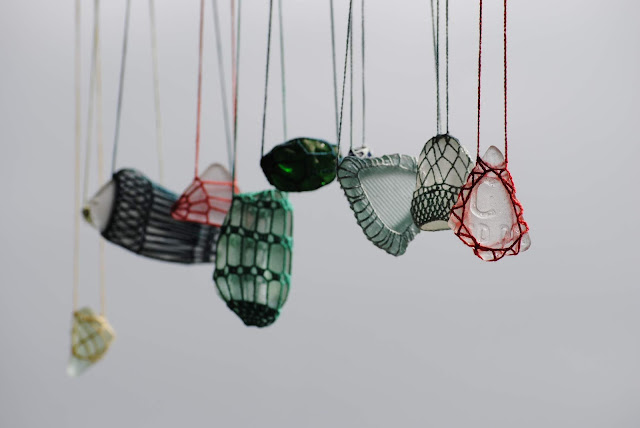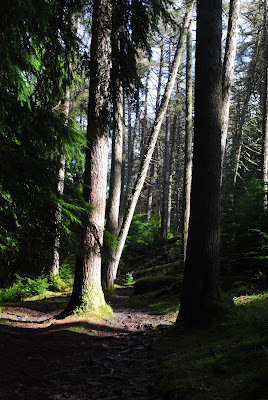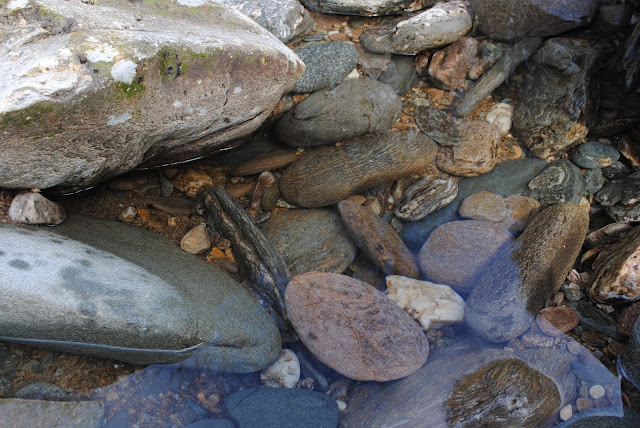In the Yonne region of Bourgogne, hovering on the map amongst a scattered constellation of villages with names full of hyphens and restaurants serving dubiously filled sausages, is the chantier de Guédelon. A twenty-year-plus project, now many years in progress, the idea was to build a medieval castle from scratch, using authentic tools, materials, and methods. And there are the costumes too, apparently a vitally important aspect. It's something they call "experimental archeology". It's basically bloody nuts.

J had written a letter to the Scottish government some time ago about Guédelon, suggesting that a similar project could be used to train apprentices in Scotland. They had referred him to Historic Scotland, who said they would give him a grant to travel to Guédelon, take part in the project, and come back with his findings. I had been incorporated into the venture as an extremely nervous and substandard interpreter with a concerning lack of medieval building site vocab, and had also hand-fashioned both of our costumes as per the requirements of the 'master builder course'.
When the funding still hadn't come through two weeks before we were due to be at the site, and we were tearing our hair out over a seemingly endless amount of paperwork and innumerable obstacles, things were looking decidedly impending-disaster-y. There were flights and trains and a car to be booked, forms that still hadn't been sent, and I had accidentally dyed J's peasant shirt a delightful salmon pink rather than the advertised 'terracotta brown'. But, as they inevitably do in these situations, all sliding parts improbably slotted into place within days of us leaving the country.
So it was that we found ourselves arriving on the grounds of a partially-constructed château bright and early on a Thursday morning, after a very chilly night in a tent on what appeared to be a deserted campsite. Our first meeting was with a man who, sitting across the réfectoire table in a dusty orange smock tied with a rope belt, shuffled through our forms and said: "Aha! Les Anglais!"
"Er, well, Scottish," J said. There were effusive apologies.
We spent our first morning exploring the site on our own, and I realised that despite all my anticipatory complaining I was actually just a smidge in love with the place. It managed to combine my twin interests of timber-framed constructions and period dramas. I hopped gleefully from the basket weaver's workshop, to the fabric dyeing house, to the paddock, saying hello to every animal we crossed paths with. As we walked around the castle courtyard there was someone in the roue d'hamster, winching a stone up to the battlements. The
tap tap tap from the quarry echoed through the hallways of the upper chambers. Trailing us everywhere was the smell of wood fires and sun-drying clay. But as the morning wore on and we got closer to having to don our smocks and take to the tools, we started to wonder what we'd be asked to do. We passed the pig pen where a man was scratching a large hog with a stick.
"That man is scratching a pig with a stick," I said.
"Well now we know what we'll be doing for the next three days," J said. He took up his much-used but yet-perfected French accent, "'We will make ze rosbif pig-sctratchers scratch ze pigs.'"
(The only person who referred to us as 'rosbifs' for the whole trip was J. The other bâtisseurs did on occasion call us other things, however.)
We ate lunch in the réfectoire with everyone else, and it became apparent that they had their own cliques that made it feel like the canteen on your first day at a new school. Except the cool kids' table was full of burly French builders, and everyone was drinking wine. J and I sat together on the end of a different table and tried not to make idiots of ourselves, perhaps fearful that we really would be made to scratch the pigs if we looked too ridiculous. But Guédelon lunches were not your standard limp cafeteria dinners - they were two-course affairs, plates piled high with crudités and boeuf bourguignon and fresh baguette and cheese. They were the best meals we ate all trip. Not that we'd necessarily earned it by that point, but we would.
As we walked back into the site after lunch, now dressed in our medieval threads, I started to feel extremely self-conscious. J, in his salmon pink shirt, actually blended in well with the others. I on the other hand had suddenly realised I was wearing a bright white dress, of all things: a vision of impracticality. Casper does
Little House on the Prairie, or something. All around me were capable-looking women with their sleeves rolled up and ruddy-faced men. What on earth were they going to do with me and my noodle arms, clomping around in my granddad's steel toe caps?
"Don't worry, you'll build up that pig-scratching arm in no time," J said reassuringly.
We were introduced to the master tiler, who gave me the customary double-air-kiss before leaning in to do the same with J. Before I could say anything, there were roars of laughter. "He nearly got you!" our welcome-man cackled. Poor J laughed it off admirably, but a look of worry was crossing his face. He was the new boy and he didn't speak a word of French - an easy target for this kind of prankery.

Our afternoon was spent making huge clay bricks in wooden moulds in the tuilerie. After showing us the method, the laddish prankster boss sauntered away and only reappeared at intervals until closing time. This was actually a good thing, as it left us with a pleasant, serene chap called Phillipe who spoke enough English to have conversations with J as well as me. We wound away the hours rolling what J called "dung balls" (mixtures of clay and hay) and churning out the bricks while the curious public trickled by making enquiries. By the end of the day I was fielding questions myself, having realised that there were only really three that just recurred again and again (what are they/what's in them/what are they for?) (bricks/clay/no one knows)
The next day we turned up again and spent the first half an hour trailing the site manager, Patrice, around all the pockets of activity, looking for somewhere to put us, I gathered. We eventually ended up at the banker shed with a tailleur who had an earring like a pirate. Though he swaggered around swinging his tool belt with some bravado, he turned out to be quite a nice guy who seemed to enjoy the novelty of testing his English, though we noticed that he too seemed to disappear for most of the day, leaving us to our own devices. He set J to work on a block of sandstone (grès) so full of iron that it was nearly completely black, and later admitted that the blacker the stone the harder it was to cut.
("They give this block to the newbies," J hissed later as we took a break to contemplate the impossible stone. "They don't actually want to use it, they just keep it here as a torture device.")
I was given an elegant piece of limestone (calcaire), destined to be a step in a spiral staircase. After a frustrating hour or two I felt like I was getting the hang of using the chisel and dummy to rough out the shape, but it was hard work and it left me with a circle of rubbed-away skin on my right-hand forefinger, and a numb arm. When the pirate came back towards the end of the day he gave a satisfied 'not bad' nod to my work. It made me so glad I'd worked my fingers to the bone.
The following day was our last on the site and we were given to the mason up on the battlements, building the actual walls of the castle. Pascal had clearly given some thought to his medieval persona and had gone with a kind of jester appearance, complementing his short stature and rotund shape with a purple shirt and a pointed, gnome-like hood. He had the reddest neck I've ever seen on a person, and after a day up there in the heat of the sun we understood why.


Unlike our previous mentors, Pascal did not disappear for most of the day, but he notably did not lay a single stone. He repeatedly told us to take it easy and liked to play a game he called "ne pas faire des bêtises" (don't do anything stupid). This was basically a point system whereby he clocked up a point for any mistakes we made and whoever had the most points at the end of the day owed the other a beer.
"Ask him how we earn points," J said. I asked. He replied.
"He says that he'll give us points if he thinks we're doing well," I said. "It's totally rigged."
Pascal grinned, and sauntered off to chat to the gathering crowd.
Despite his jokes (and, as it would turn out, his tendency towards rather saucy remarks) he was a relaxing authority to work under, in that he didn't really seem to regard doing any work as a priority. The thing he enjoyed most was ringing the bell for lunch, and when J asked if he could have a go in the hamster wheel (Pascal didn't speak a word of English beyond repeating things J had just said as though tasting them in his mouth, but the two of them had managed to establish a kind of communication system that transcended language) he was more than happy to oblige. At first he gave me the job of bringing the stone in from the pulley, but when I couldn't lift the heavy trap doors he sent me down to operate the brakes instead. As he demonstrated how to work them he looked at me very seriously and more or less told me that if I wanted J to not die, I should probably do this right. J gave me a thumbs up from inside the wheel.
We hoisted the stone up to the top without incident, and shortly afterwards Pascal said it was finishing time. I looked at him suspiciously, and asked "Really?"
"That's what my watch says," he shrugged. I looked. His watch was an hour fast.
We left Guédelon for the last time, shrugging off our medieval clothes and stretching our aching arms. It was the closest I'll ever come to going back in time, and it was weird, and French, and weirdly French. There are stones on the left-hand battlements of a real-life castle that I laid, and when that specific section of wall crumbles down prematurely, I will remind everyone that Pascal told us to take it easy.





















































